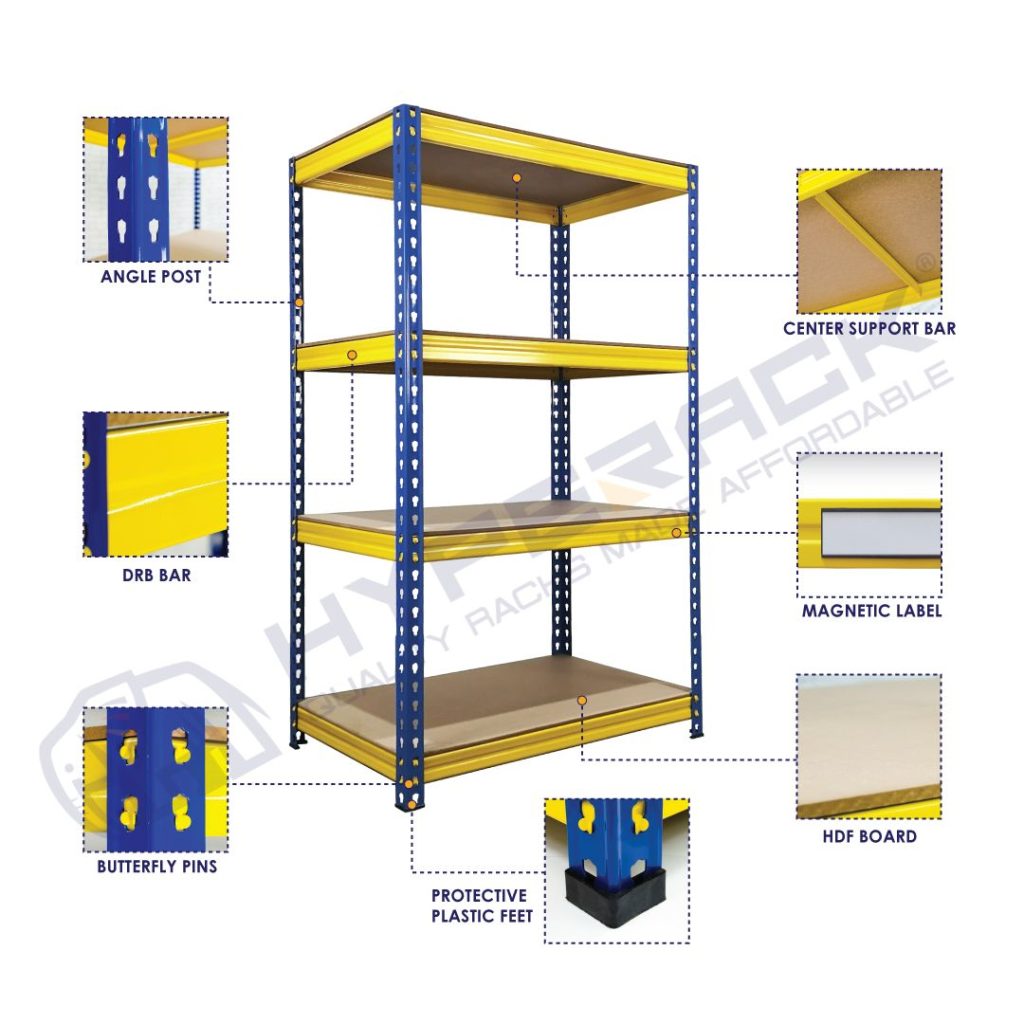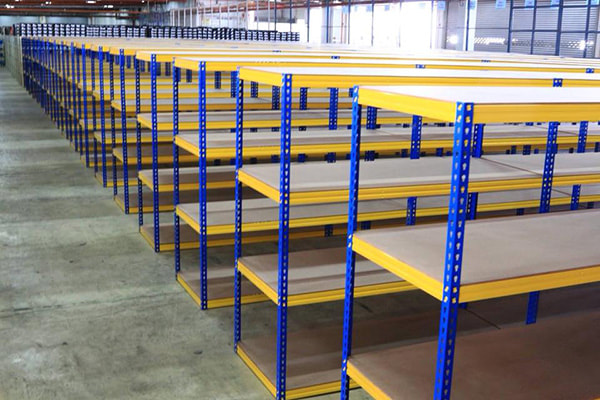Boltless racks are a highly adaptable and user-friendly storage solution popular in warehouses, workshops, retail spaces, and even home garages. Built with a unique rivet or clip system, these racks offer strength and versatility without requiring bolts or screws. Whether you’re managing a commercial facility or organizing your tools at home, boltless racks provide a hassle-free, durable way to maximize storage space.
What Are Boltless Racks?
Boltless racks are a type of shelving system that requires no nuts, bolts, or screws for assembly. They use a rivet lock or clip system, making them easy to install and adjust without tools. Boltless racks are popular for their flexibility, strength, and ease of setup in both commercial and residential spaces.
How Boltless Racks Work?
Boltless racks use a rivet lock or clip system to securely connect beams and uprights, allowing easy assembly without any tools or hardware. Each shelf level clicks into place, creating a sturdy structure that can hold various weights depending on the rack type. This assembly process simplifies installation, making boltless racks ideal for businesses and homeowners who need a fast, flexible storage solution.

What Types of Boltless Racks Are Available?
There are several types of boltless racks to suit different needs:
- Heavy-Duty Boltless Racks: For industrial use, supporting large, heavy items.
- Medium-Duty Boltless Racks: Common in retail or smaller warehouses, balancing cost and strength.
- Light-Duty Boltless Racks: Ideal for home use, holding lighter items and storage boxes.
What Are the Main Benefits of Boltless Racks?
Boltless racks offer several unique advantages:
- Quick Assembly: Easy to put together without bolts or tools.
- Adjustability: Shelves can be moved up or down based on storage needs.
- Durability: Made with steel or aluminum, they offer long-lasting strength.
- Cost-Effective: Generally more affordable due to simplified design and assembly.
What Materials Are Boltless Racks Made From?
Most boltless racks are made from steel or aluminum for durability. Shelves can be made from materials like particleboard for light-duty use, or metal for heavier applications. Many boltless racks use recyclable materials, making them an eco-friendly option for storage.
Where Can Boltless Racks Be Used?
Boltless racks are versatile and can be used in a variety of settings:
- Warehouses: For storing inventory and heavy items.
- Retail: Ideal for backroom or display storage.
- Home Storage: Perfect for tools and equipment organization.
- Libraries and Archives: Useful for books, records, and files.
How Do I Install Boltless Racks?
Here’s a simple guide to installing boltless racks:
- Plan Layout: Determine where the racks will go and ensure enough space.
- Assemble Uprights and Beams: Insert beams into the uprights using the clip system.
- Add Shelves: Place shelves at your desired height.
- Secure if Needed: For added stability, especially with heavy-duty racks, secure to the floor or wall.
- Tutorial Video: Click Here
How Much Do Boltless Racks Cost?
The cost of boltless racks varies:
- Light-Duty Racks: Below RM100 – Check Here
- Medium-Duty Racks: Typically range from RM100–RM200 – Check Here
- Heavy-Duty Racks: Depending on size and material. Pricing depends on the rack’s weight capacity, material quality, and overall design. – Check Here
What Weight Can Boltless Racks Hold?
Boltless racks can handle a range of weights depending on their type:
- Light-Duty: Typically support up to 400kg totally, OR 100kg Per Level
- Medium-Duty: Can hold up to 800kg totally, OR 200kg Per Level
- Heavy-Duty: Often support over 1,600 kg totally., OR 400kg Per Level, but make sure to check the manufacturer’s specifications, as exceeding these limits can compromise the rack’s stability and durability.
Can I Use Boltless Racks Outdoors?
Yes, boltless racks can be used outdoors, but choose racks specifically designed or coated for outdoor use:
- Rust-Resistant Coatings: Look for powder-coated steel or galvanized racks for rust prevention.
- Weather Considerations: If exposed to rain or high humidity, protect shelves with waterproof covers or use metal shelving instead of particleboard, which may warp.
Do Boltless Racks Require Maintenance?
Although low-maintenance, boltless racks benefit from periodic checks:
- Inspect Joints: Ensure beams and uprights are securely locked to maintain load-bearing capacity.
- Dust and Clean: Regular cleaning, especially for food and retail storage, helps maintain hygiene and prolongs shelf life.
Can Boltless Racks Be Customized?
Yes, boltless racks offer various customization options to suit specific needs:
- Adjustable Shelves: Most boltless racks allow you to change the height of each shelf.
- Add-On Units: Some brands provide add-ons to expand storage capacity without buying a separate rack.
- Accessories: You can find bins, hooks, and dividers compatible with boltless racks to organize tools, small parts, or files.
Are Boltless Racks Flood-Resistant?
Boltless racks are not inherently flood-resistant, but certain modifications can improve their resilience in flood-prone areas:
- Material Choice: Opt for racks made from galvanized or powder-coated steel to resist rust and corrosion if they come into contact with water.
- Shelf Type: Use metal or wire shelving instead of particleboard or MDF, which can warp, swell, or degrade in high moisture.
- Elevated Placement: Where possible, place the racks on platforms or pallets to keep them above floodwater. This minimizes direct contact and protects stored items.
- Regular Maintenance: Inspect racks periodically, especially in flood-prone regions, to ensure there is no rust or weakening in the structure.
While these measures won’t make boltless racks entirely flood-proof, they can help improve their durability and longevity in damp or wet conditions.
Are Boltless Racks Fire-Resistant?
Boltless racks are not fireproof, but they can withstand certain levels of heat based on their materials:
- Metal Shelves: Metal shelves are more heat-resistant than wood or particleboard, which can burn or warp in extreme temperatures.
- Coated Steel: Powder-coated steel can withstand higher temperatures without degrading quickly, offering slight fire resistance. For storage areas that require fire resistance, such as industrial settings, consider using fully metal racks and ensuring the storage area has adequate fire safety measures.
How Long Can Boltless Racks Last?
The lifespan of boltless racks depends on several factors, including material quality, usage, and environmental conditions. Generally:
- High-Quality Steel Racks: When properly maintained, boltless racks made of high-quality steel can last anywhere from 90 to 200 years, especially in dry, indoor environments.
- Humidity and Corrosion: In humid or coastal areas, racks may need rust-resistant coatings, like powder coating or galvanization, to prevent corrosion. With these coatings, they can still last a decade or more.
- Load Capacity: Regularly loading racks close to or above their weight limit may cause structural fatigue over time, potentially shortening their lifespan. Heavy-duty racks used within their capacity limits are more likely to remain durable.
- Maintenance and Care: Regular inspections, cleaning, and proper storage practices can extend the life of boltless racks, as these reduce risks from rust or structural wear.
With proper care and ideal conditions, boltless racks are a long-lasting storage solution for homes, garages, warehouses, and retail spaces.
Are Boltless Racks Safe for Kids?
To make boltless racks safer in areas accessible to children, follow these safety precautions:
- Put Racks Close Walls: Prevent tipping by securing racks to walls, especially taller units.
- Keep Heavier Items on Bottom Shelves: Storing heavy items on lower shelves improves stability and reduces the risk of items falling from height.
- Edge Guards: Use rubber edge guards given to minimize the risk of injuries from sharp metal edges.
How Do Boltless Racks Compare to Traditional Bolt Racks?
Boltless racks are often chosen over traditional bolt racks for the following reasons:
- Faster Assembly: Without bolts, assembly is quicker and usually tool-free, making setup simple.
- Flexibility: Boltless racks allow for easy reconfiguration, while traditional bolt racks are more fixed.
- Cost and Convenience: Boltless racks are often more affordable and don’t require specialized tools, making them popular for both home and commercial use. However, traditional bolt racks may offer higher load capacities for certain heavy-duty industrial applications.
Can Boltless Racks Be Used for Hanging Items
Yes, boltless racks can be adapted for hanging items:
- Hooks and Hangers: You can install hooks or hangers on the shelves or beams of the rack to store items such as bags, coats, or tools.
- Adjustable Heights: The open design of boltless racks allows flexibility in the placement of hooks or rods, making them versatile for different types of hanging storage.
- Weight Limit: Always ensure that the weight of the hanging items does not exceed the weight capacity of the rack.

How Do Boltless Racks Perform in Cold or Hot Environments?
Boltless racks generally perform well in both cold and hot environments, but with some important considerations for extreme temperatures:
- Cold Environments:
- Material Considerations: In cold environments, such as freezers or refrigerated storage areas, it’s essential to choose racks made from corrosion-resistant materials, like stainless steel or galvanized steel. These materials can withstand the moisture and low temperatures typical of cold storage.
- Avoid Plywood or MDF Shelving: Shelving made from plywood or MDF (Medium-Density Fiberboard) may not perform well in extremely cold environments, as these materials can absorb moisture and become warped or damaged. Instead, opt for metal or other heat-resistant shelving options that are more durable and stable in freezing conditions.
- Rust Prevention: Moisture in cold environments can cause rust, so it’s crucial to maintain the racks in a dry state and check for any signs of corrosion. Regular maintenance can extend the life of the rack in cold conditions.
- Hot Environments:
- Heat-Resistant Materials: In high-temperature environments (such as industrial kitchens, factories, or areas near machinery), choose racks made of heat-resistant materials. Steel racks with heat-treated finishes or specialized coatings designed to withstand high temperatures are ideal. Avoid using materials like plywood, which can warp or degrade when exposed to extreme heat.
- Ventilation: The open design of boltless racks allows for good air circulation, which can be beneficial in hot environments to prevent heat buildup. Proper ventilation ensures that items are not subjected to prolonged heat exposure, which could lead to damage.
- Shelf Stability: In extremely hot conditions, ensure that the shelves are designed to handle the expansion or contraction of materials caused by temperature fluctuations. Metal racks with proper support structures will perform better in these environments.
In summary, boltless racks can perform well in both cold and hot environments if you choose the right materials. For cold environments, metal shelves are preferable over wood-based options, while for hot environments, ensure the racks are heat-resistant and have adequate ventilation. Avoid plywood and MDF in extreme temperatures to maintain the integrity of your racking system.
Are Boltless Racks Easy to Move?
Yes, boltless racks are typically easy to move, but there are a few considerations:
- Lightweight Construction: Many boltless racks are made of lightweight materials, making them easy to carry and reposition as needed.
- Disassembly and Reassembly: Because they are designed for easy assembly, you can often disassemble and reassemble the racks with little effort, which is convenient for moving them to new locations.
- Rolling Racks: Some boltless racks come with optional caster wheels, further improving mobility and ease of transportation.


